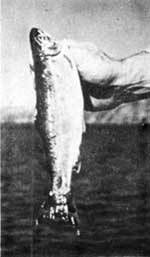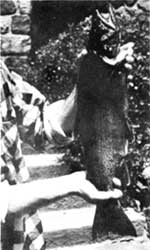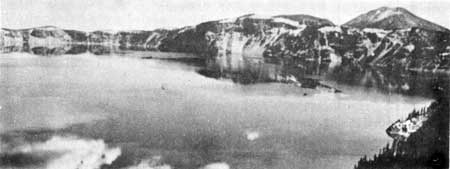Fishing At Crater Lake National Park
Photos by C. Warren Fairbanks
PART I – STREAMS
Many park visitors are interested in the fishing conditions here in Crater Lake National Park. In most cases, fishing is limited. For example, the streams are very hard to reach. Annie Creek and Castle Creek are cut into steep canyons with sheer walls. Brush is also a handicap to the fisherman. Sand Creek at the East Entrance, where the pinnacles are located, is a prime example of stream conditions; this stream can be seen from the highway.
Small rainbow trout, Salmo gairdneri irideus Gibbons, and eastern brook trout, Salvelinus fontinalis (Mitchill) are abundant in the streams. The size of the trout caught in these streams averages about eight inches. One of the reasons for the smallness of the trout is that the snow pack is very deep in these canyons, reducing the food supply by covering the streams. From late in July until September, these streams are usually free from snow.
Bait fishing is a good standby that brings fine results. Fly fishing is almost useless because of the brush cover in the area. Spin fishing is difficult, the streams being too small.
If the hardy fisherman can overcome these handicaps, however, he should be able to catch his limit of ten fish in these beautiful mountain brooks.
PART II – THE LAKE
Crater Lake, in addition to being one of the most beautiful lakes in the world and, according to some, one of the seven natural wonders of the earth, is also one of the most interesting as far as angling is concerned.
There are two main types of fish in the lake. The first is the landlocked red, sockeye, or kokanee salmon, Oncorhynchus nerka kennerlyi (Suckley), which I do not consider to be a good type of fish for this lake. They do not grow very large, and, as far as angling is concerned, I can not consider them game fish. These fish range between nine and thirteen inches in length. Very seldom is a fish caught that is larger or smaller. They are small in body structure and weigh little for their size.
 Sockeye salmon from Crater Lake |
The rainbow trout, Salmo gairdneri irideus Gibbons, in Crater Lake, however, is a much different fish in comparison with the salmon. This fish grows large and is a vicious fighter. Like most lakes that fishermen enjoy, Crater Lake could be one of their favorites if they understood the habits of the rainbow trout in this lake. The park visitor who fishes in the lake is usually not familiar with the habits of these trout. Therefore, many draw a wrong conclusion about the great fishing that Crater Lake offers.
The length of the rainbow ranges between fifteen and one-half and twenty-three inches, the average measuring nineteen inches and weighing about three pounds. These fish are deep feeders, the reason being that the summer is so short that surface feeding for bugs is limited. Some say the water is so clear that, in order to escape the rays of the sun, they have to seek shelter in deep water or under overhanging rocks.
Trolling at around seventy feet deep produces fine results; however, it is not great sport because of the weight of the spoons and sinkers. Spin fishing is the sport in the lake. With a light spinning rod and a light-test line, using a quarter-ounce lure, a fisherman will have a wonderful time on the lake; but along with all this, he will have many heartaches.
 23-3/4-inch rainbow trout taken from Crater Lake in August, 1954 |
The mouths of the trout are very soft. Once hooked, these fish break water and in two or three jumps are usually free. The fisherman can expect to land one of every five that he hooks. There have been many stories which attempt to explain their tearing loose so easily. One possible suggestion is that the lack of minerals in the water has a weakening effect on the cartilage of their mouths. As a sidelight, let me describe one of the strangest things about the rainbow trout in Crater Lake. Once free, after breaking loose from the hook, they continue to jump and break water, sometimes three feet into the air. They may do this five or six times. An explanation for this might be that their mouths are so soft that, having been torn by the hook, they are actually in pain.
Very seldom does a fisherman catch a large rainbow on a flyrod using artificial flies. Using a fly road limits one in the length of cast. Also, the fish sees the movement through the clear water and will not strike. Anglers have spent days on the lake without seeing a fish rise for a live bug or fly. This seems strange for a lake that has been stocked many years with rainbow trout.
Unless certain problems are solved in the future, good fishing in the lake may cease. Crater Lake can not stand heavy fishing; the fish do not reproduce in quantity. Contrary to popular opinion, I believe that lack of food is not the handicap to reproduction in this lake. There are many types of underwater life for the fish to feed on.
The grave problem is the absence of adequate spawning grounds. There are no known inlets or outlets to Crater Lake, providing an unfavorable situation for spawning trout. They must, therefore, find nesting grounds in the lake. There are located around its edges a few sandy beaches that otherwise would be ideal, but the wind creates such choppy water that the roe would be washed away. The light pumicesand also shifts around in the water. The spawner probably lays her eggs in the holes and cracks of the steep walls around the shores of the lake. This is not an ideal situation, because the eggs have little protection from other fish. When the eggs have hatched, the fingerlings fall prey to their own cannibalistic kind; apparently few escape this fate. If the fish that do escape and reach maturity are caught by the angler, then the supply may be exhausted.

Looking toward Mt. Scott from Sinnott Memorial
From Kodachrome by Welles & Welles
Views From Sinnott Memorial
By Willis G. Downing, Ranger Naturalist

